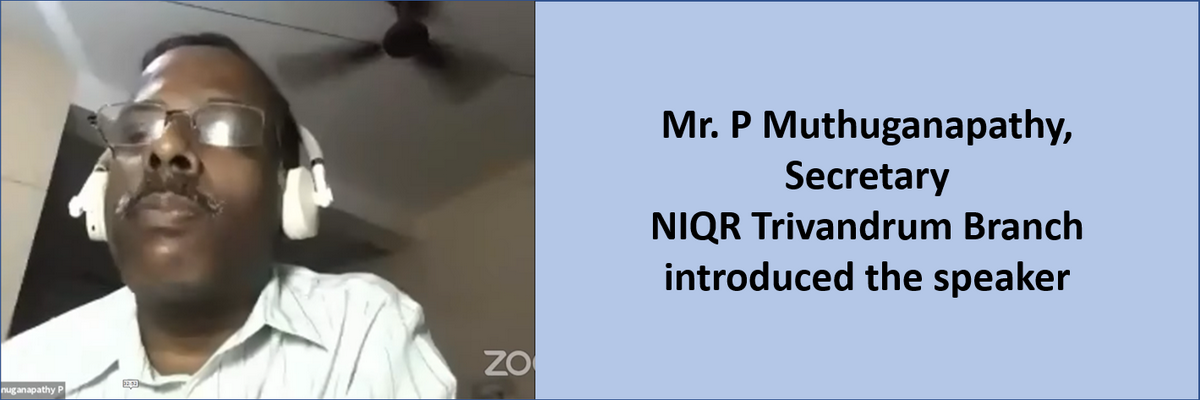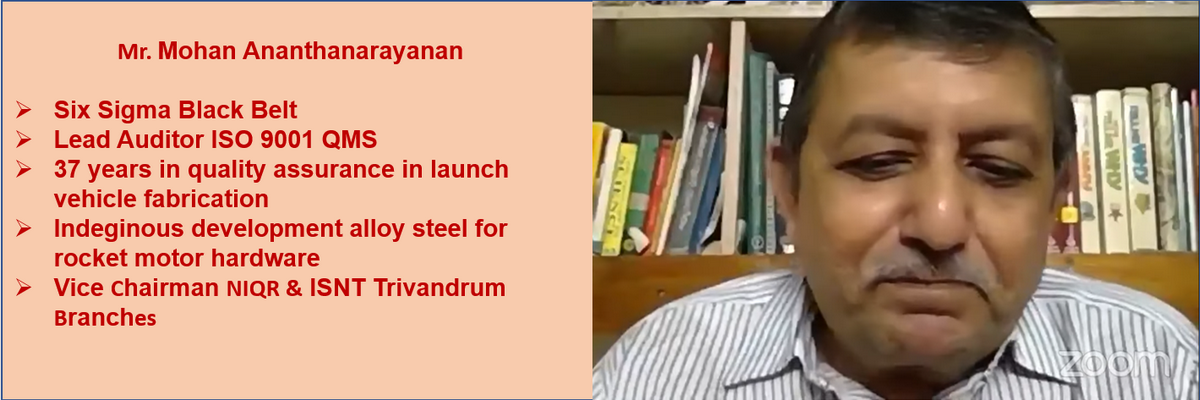






Webinar on “MONOZUKURI” and “HITOZUKURI”
NIQR Trivandrum Branch and Amal Jothi College of engineering, Kanjirapally jointly organised a Webinar on “MONOZUKURI” and “HITOZUKURI” on 16th September, 2020.
Shri. K R Mohan Aanthanarayanan, Retd.Head Quality Division Mechanical VSSC Vice-chairman NIQR Trivandrum Branch was the faculty which was attended by more than 120 students and professionals.
Mr. Sherin Thambi, Assistant Professor, Amal Jyothi College of Engineering welcomed the participants and started the proceedings with the display of a video about NIQR.
Mr. C Athi Pagavan, former Group Director, RQA-SISG, IISU and Chairman, NIQR Trivandrum Branch inaugurated the webinar and spoke at length about the activities of NIQR especially for Institutions. Mr. P Muthuganapathy, Secretary NIQR Trivandrum Branch introduced the speaker to the audience.
.Mr. Aanthanarayanan started the session with a house hold example for necessity of conscious manufacturing. His session was filled with many examples to keep the interest of the audience in a virtual lecture.
The Q&A session was more of appreciation of the way the subject was dealt by the speaker.
Mr. Sherin Thambi proposed the vote of thanks.
The gist of the lecture is given below.
At a time when there is a great stress for self-dependant and self-sustaining work culture in the country, Conscious Manufacturing, ‘self’ embedded system, has to be implemented. The two organisational methods Monozukuri and Hitosukuri show the way forward in conscious manufacturing.
The term conscious manufacturing applies to all types of work that needs perfection. Think of cooking for example, if you are not conscious as you cook the result would be disastrous. You have to not only put salt and pepper but also your heart and soul so as to make the product palatable. In the same manner we have to be very conscious of the outcome as we manufacture. Monozukuri and Hitozukuri help in shaping the way for conscious manufacturing.
Monozukuri is a century-old, Japanese philosophy in craftsmanship. The word “mono” stands for product, while “zukuri” translates to making or creating. Making products is a culmination of craftsmanship among dedicated workmen. It blends the local cultural mind set with work ethics driven by continuous improvement for perfection. In general the term unites the physical attributes of a product (e.g., aesthetic, usefulness, well-design, craftsmanship quality, etc.) and the personal aspects of its maker (e.g., pride, commitment, passion, etc.) into the process of making things. The ancient architecture, trade, innovation and industrial development can be traced to this quality of synchronisation of the maker and the make. In a self dependant and self sustaining work culture the aspects of Monozukri has to be applied to the factors of production viz; Material, Machine, Method, Human, Money and Environment.
The essence is to make parts better. In order to make better there needs to be a structure for continuous improvement within the organization. We have quality management system that defines the basic system with which effective improvements can be worked out. Integrated concept of quality improvement processes in manufacturing, Kaizen Work flow, making teams to work together, following unique objectives, Improving end to end cost performance, effective channelizing of Human capital are all a part of making things better. However it has been observed that with all these tools, slackness in the system occurs, products do not perform to the satisfaction of the customers. Monozukuri recognizes this fact more than any other organization tools and stipulates that making people better as the first step to making things better. Making people better is termed as ‘Hitozukuri’. ‘We make people before we make parts’ is a quote from a top engineer from Toyota group.
Prof. W. Edwards Deming well thought out statements on creating constancy of purpose for improving products and services, removing barriers that rob people of pride of workmanship, drive out fear are the foundation for making people and things better. Hitozukuri is making people by constantly developing technical skills and the ability to solve problems with others in an atmosphere of mutual trust. The key term here is the atmosphere of mutual trust. This is an aspect of Deming’s 14 points where he says drive out fear so that everyone may work effectively.
Making people involves identification of the natural ability of a person and honing his skill through training aided with technology. It involves the following
- Making him know the content and aspects of work in depth where he has inclination. There are skills like drawing that are innate and can be developed very usefully in design of structures.
- People should feel their progress not only in the completion of challenging jobs but in facing more challenging assignments. This happiness within or the work satisfaction has to evolve with management support. Tools, fixtures and machines evolve with continuous challenges faced by shop floor personnel.
- Motivating the people by appreciation of their work and providing training for better quality is the next factor. CNC machines have very much become the workhorse in precision machining today. Yet it is a black box for many who work on it and breaks down wait for the supplier maintenance engineer to turn up. People in-sight into the working of the machines can be improved by training.
- People should be allowed to think taking time instead of just repeating production and meeting the targets. There was a problem of having a null grinding set up for an actuator. After repeated attempts in the company this could not be achieved. Then a machining sub-contractor who saw this problem agreed to set it right. All he wanted was a free hand to make a set up and take a trail with his own time limits. Working on a challenge with skill reduces the time limits on its own and within a week he succeeded in his small shop with an old machine. It was very cost effective too. Such people have to be identified and encouraged.
Monozurki recognizes the fact that humans are prime drivers and their ingenuity is the key for development of products and services that perform maintain quality and are offered at affordable price. In highly automated processes there are two aspects that aid monozurki. They are
- Standards: A repetitive works hinges on the predictability of the process through defined set of working variables. But then there are unpredictable events that are encountered. These have to be solved by humans.
- Jidoka: In order to solve unpredictable problems it is important to make problematic situations and deviations from the standard appear as quickly. It helps to look at the conditions of the problem while they remain. Development machine diagnostics and alert systems fall in this category. When problems are solved the methods are incorporated into procedures and standards as workflow Kaizen.
Stop, diagnose, fix and go methodology is to be adopted when unpredictable problem occurs. A printer is designed with this objective, when a paper gets stuck, we stop diagnose, take the paper out and the go. In complicated systems like space systems a failure may not as evident and this requires in depth failure analysis where depth of technical knowledge and human disciplines like integrity are of utmost importance.
In an organisation Monozukuri and Hitozukuri go hand in hand to enrich the work culture embedding indigenous skill to perfection.
© 2021. All rights reserved | Design by TRIVAM TECHNO SOLUTIONS
